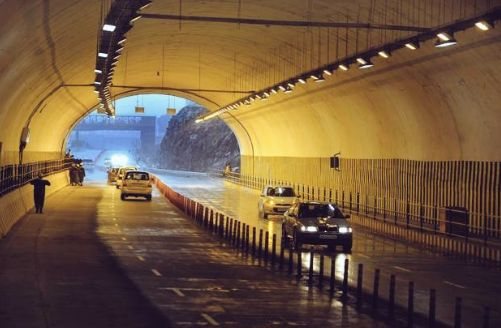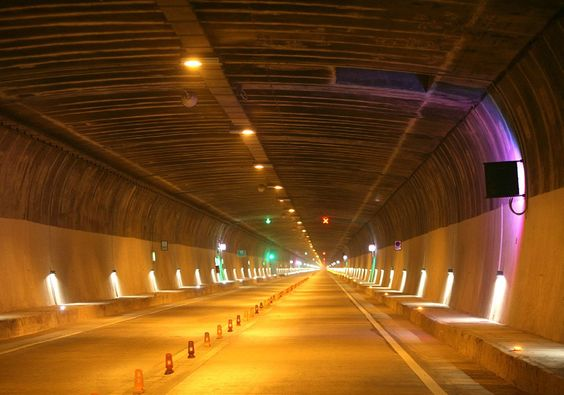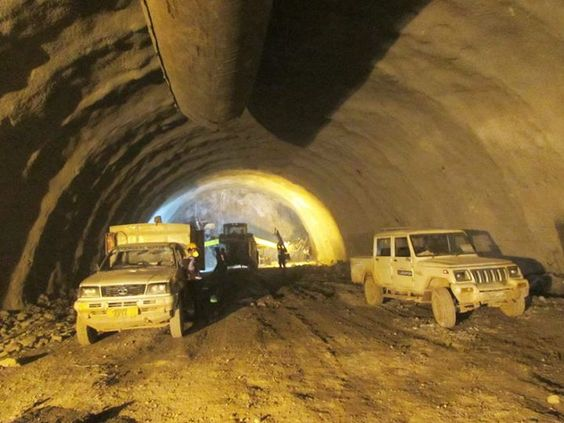The Chenani-Nashri Tunnel, also known as Patnitop Tunnel, which is situated on the two-lane highway connecting Jammu to Srinagar. In south-eastern Asia, in Jammu and Kashmir, it is the longest active tunnel that is currently being built.
When Chenani Nashri Tunnel opened for traffic in April 2017, also known as the Dr Syama Prasad Mookerjee Tunnel, it became India’s longest road tunnel project. The 9.28 km-long Patnitop Tunnel, which was constructed at the foot of the Himalayas, links the Chenani and Nashri districts.

Source: Pinterest
See also: Channel Tunnel: Know Eurotunnel’s history and architecture
The Patnitop Tunnel is a component of the National Highway 1A (NH1A) between Srinagar and Jammu’s proposed four-lane widening. The tunnel serves as a replacement for the current NH1A section, which has safety and geometric issues because it traverses rocky, mountainous terrain. Due to bad weather, the highway is shut for 40 days each year.
The two-line, bi-directional traffic tunnel functions all year long as a dependable, all-weather route. It cuts the distance and travel time between Jammu and Srinagar in half, from 41 km to 10 km. As part of the Rs 100bn ($2.2bn) in highway projects in Jammu and Kashmir, another 8.45 km tunnel is also being built between Qazigund and Banihal.
Chenani Nashri Tunnel: Route and features
The project involved building a 13.3-meter-diameter, two-lane, single-tube main tunnel as well as a parallel, 5-metre-diameter escape tunnel. Every 300 and 1,200 metres, respectively, a pedestrian and a vehicular disaster cross passage connect the main tunnel to the escape tunnel. It connects the villages of Chenani and Nashri by traversing the lower Himalayan mountain range.
The four-lane Udhampur to Ramban Section of NH-1A is bypassed by the horseshoe-shaped tunnel, which also has two rotary junctions. The Patnitop range of the Himalayas’ fleshed geological formation is where it passes. The maximum overburden in the Chenani-Nashri tunnel is 1,050 metres. The existing highway’s altitude and hairpin bends are decreased. Additionally, the gradient is lowered from 4.5% to roughly 0.5%.

Source: Pinterest
see also about: Channel Tunnel
Chenani Nashri Tunnel: Construction details
The New Austrian Tunnelling Method (NATM) was employed during construction. The tunnel was successively dug out and supported under NATM. As the project required cutting Himalayan rocks, it was complicated. For the project, cutting-edge drilling and tunnelling machinery were employed.

Source: Pinterest
Beginning in September 2011, tunnel construction was finished in early 2017. The contractors faced numerous management and engineering challenges as a result of the tunnel’s remote location in the mountain ranges, its geology, and its logistical limitations.
The initial stage of tunnel construction through all the hills involved using trinitrotoluene (TNT) explosions. The project involved building a 10.9 km long highway overall, as well as a 9 km tunnel, a 50 m single-span bridge at the tunnel’s north portal, and a 40 m single-span impending bridge at the tunnel’s south portal.
In contrast to the north-approaching portal, which needed 0.6 km of embankments and slope cuttings, the south section required 1.3 km of surface work. Other infrastructure included toll booths, other project facilities, technology and service buildings, and soil disposal areas.
Chenani Nashri Tunnel: Cost
IL&FS Transportation Networks (ITNL) was chosen in May 2010 for the design, build, finance, and operation of the four lanes of the 41 km NH1A highway (from 89 km to 130 km, which includes the Chenani-Nashri tunnel). This project involved financing India’s longest road tunnel.
The National Highways Authority of India (NHAI) will pay the concessionaire an annuity for a period of 20 years. For the project’s execution, ITNL created the Chenani Nashri Tunnelway (CNTL), a special-purpose vehicle.
A group of 12 banks, led by the State Bank of India’s Funding Strategic Business Unit, provided the project’s funding. NHIA and Louis Berger Group conducted feasibility studies for highway construction and rehabilitation in 2006 and 2007. A sub-consultant was D2 Consult Prague.
Leighton Welspun Contractors was given an engineering, procurement, and construction lump sum, fixed-price contract by ITNL for the Patnitop Tunnel project in July 2010. The contract’s scope included work on lighting and ventilation, SCADA, traffic monitoring, surveillance cameras, emergency call and communications systems, and architectural, structural, civil, electrical, and mechanical systems.
The Chenani-Nashri Tunnel project received detailed planning and construction management from GEODATA.
FAQs
How long is the Chenani-Nashri Tunnel?
The Chenani-Nashri Tunnel is not only the longest highway tunnel in India (9 km) but also the longest highway tunnel in Asia.
What is the new name of the Chenani-Nashri Tunnel?
The Chenani Nashri Tunnel was renamed the Dr Syama Prasad Mookerjee Tunnel.
| Got any questions or point of view on our article? We would love to hear from you.
Write to our Editor-in-Chief Jhumur Ghosh at [email protected] |
Housing News Desk is the news desk of leading online real estate portal, Housing.com. Housing News Desk focuses on a variety of topics such as real estate laws, taxes, current news, property trends, home loans, rentals, décor, green homes, home improvement, etc. The main objective of the news desk, is to cover the real estate sector from the perspective of providing information that is useful to the end-user.
Facebook: https://www.facebook.com/housing.com/
Twitter: https://twitter.com/Housing
Email: [email protected]











